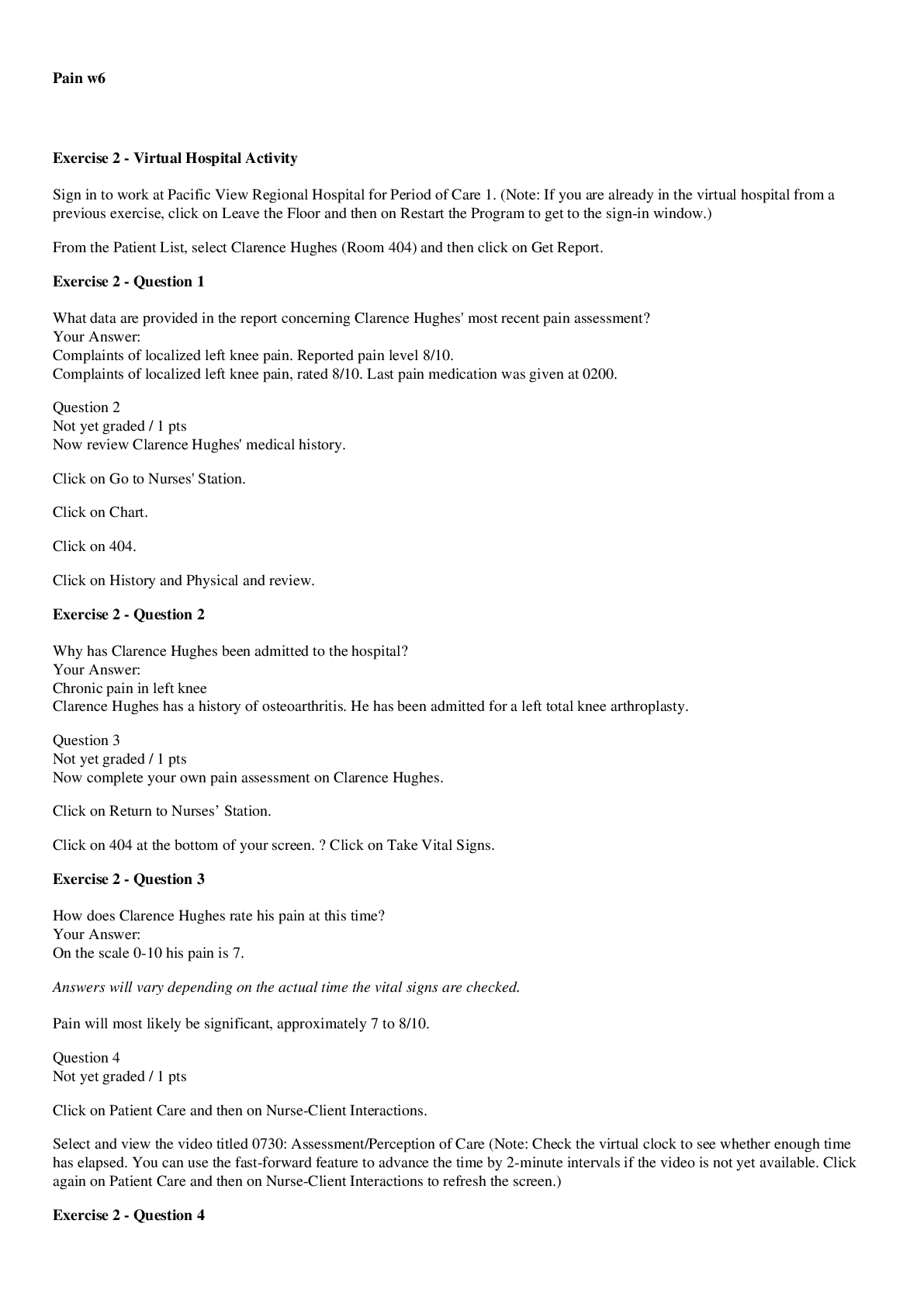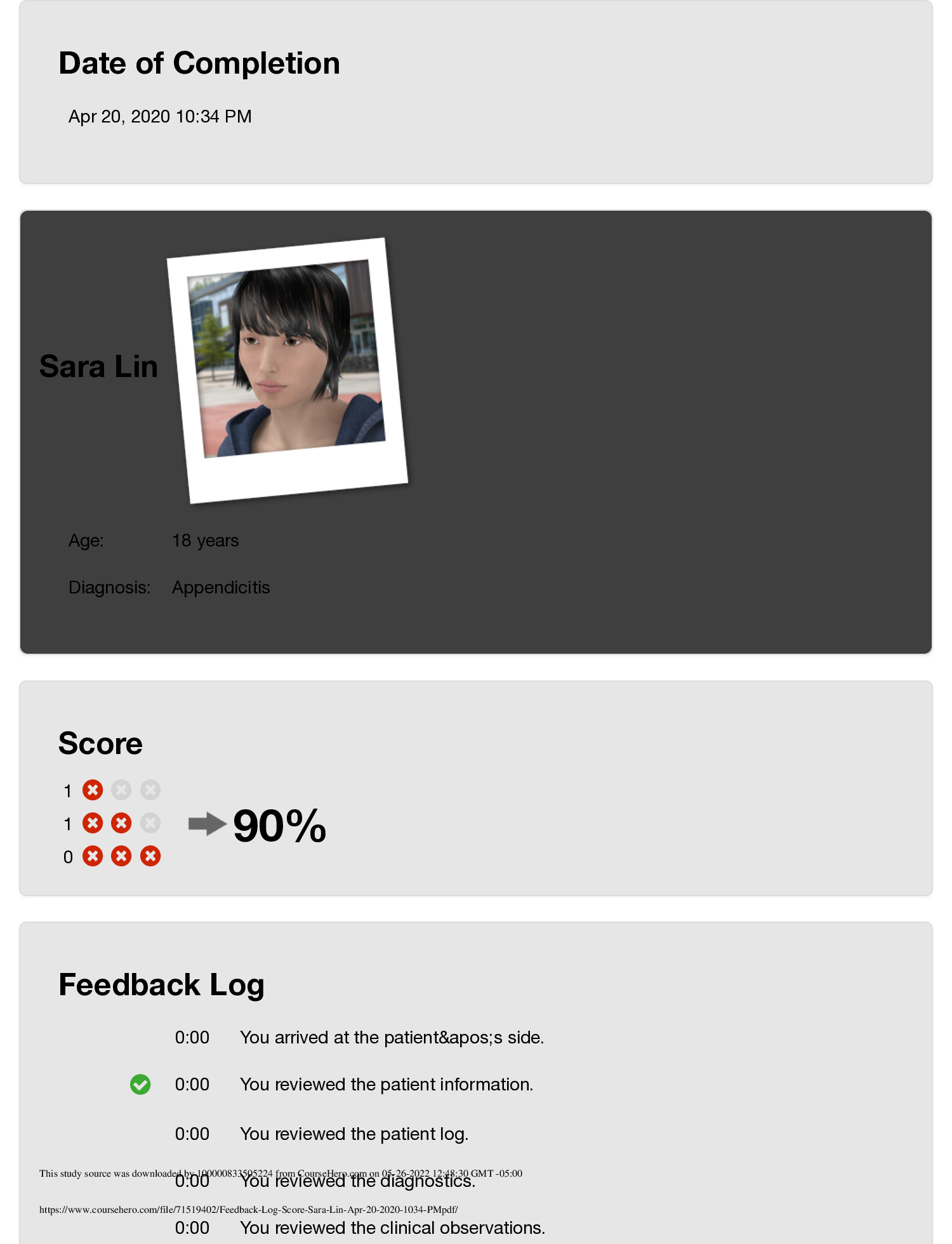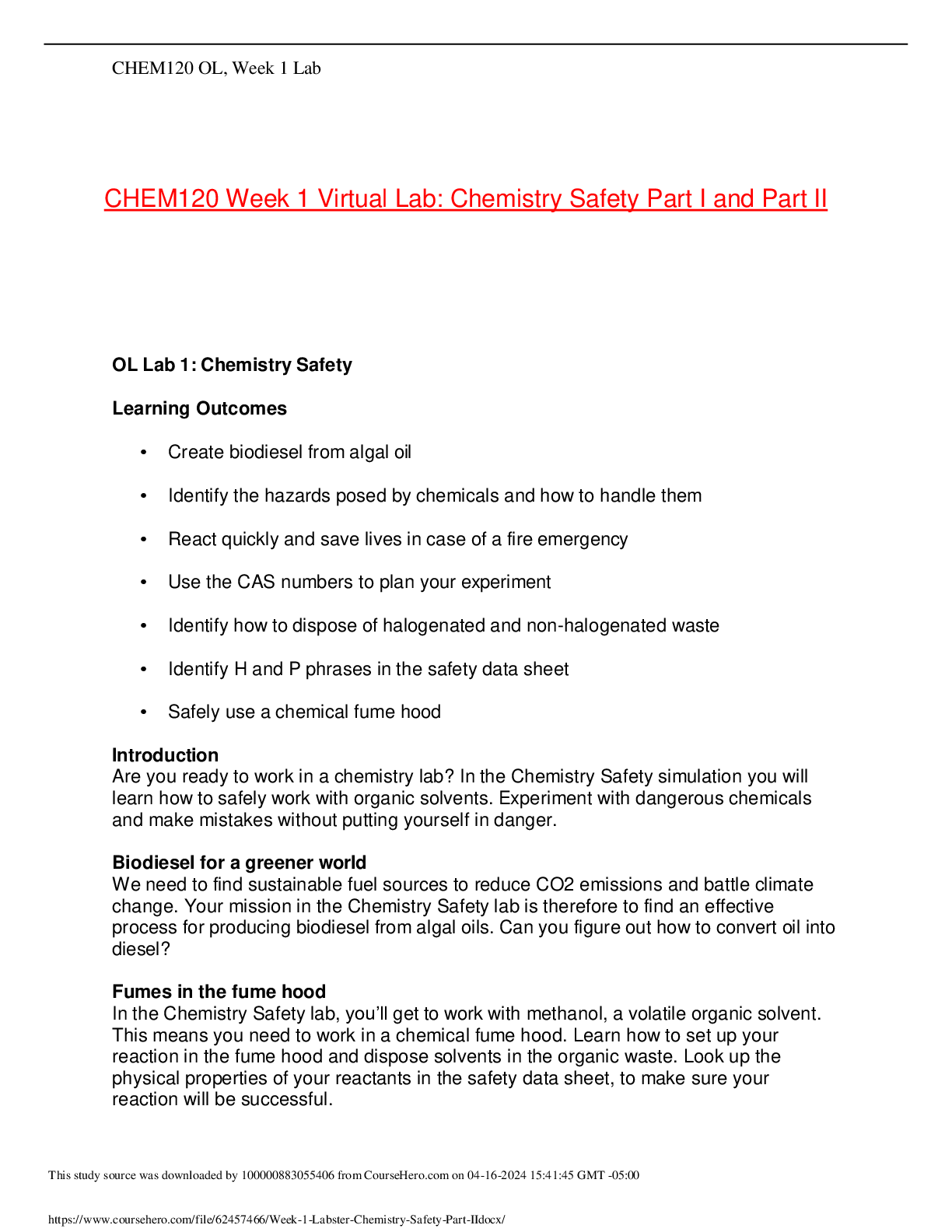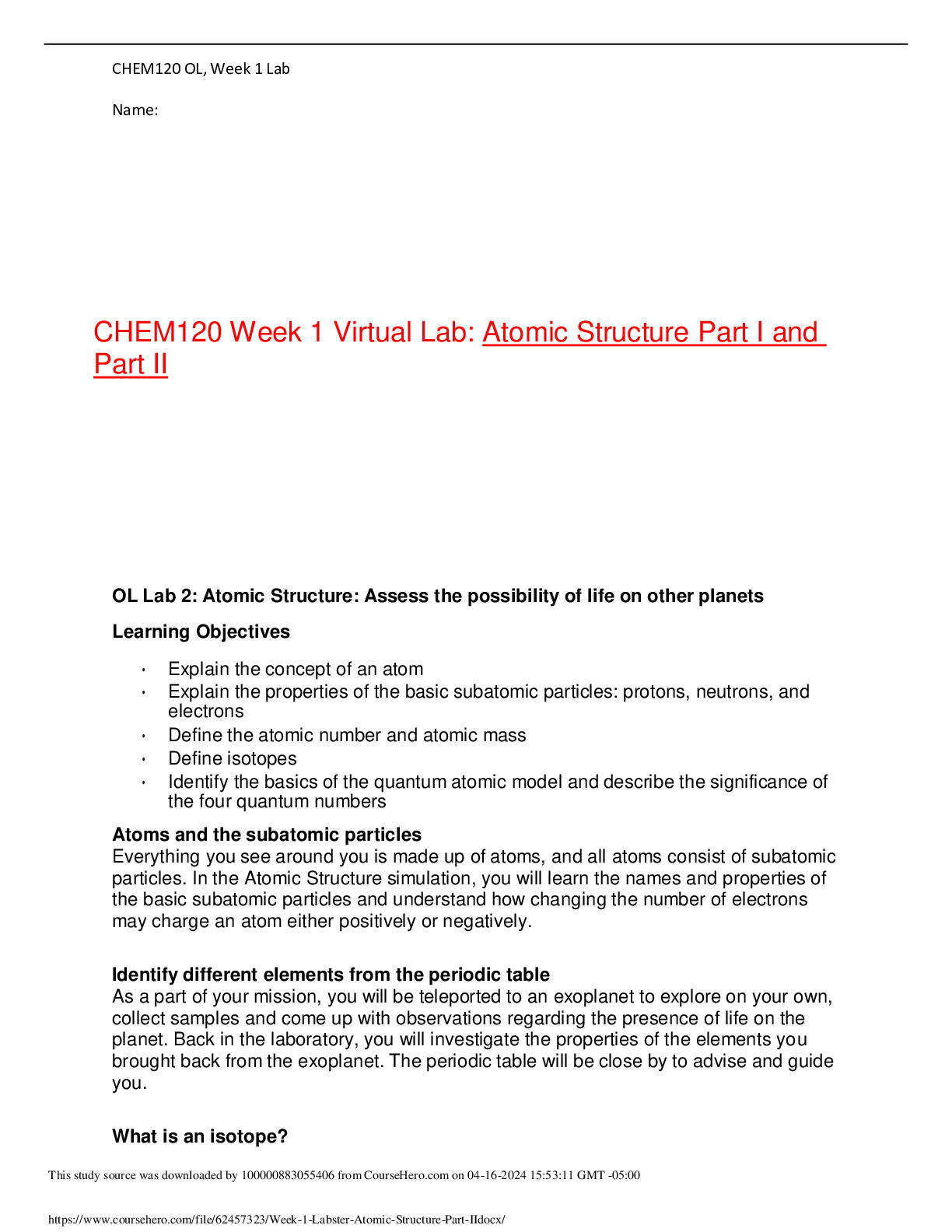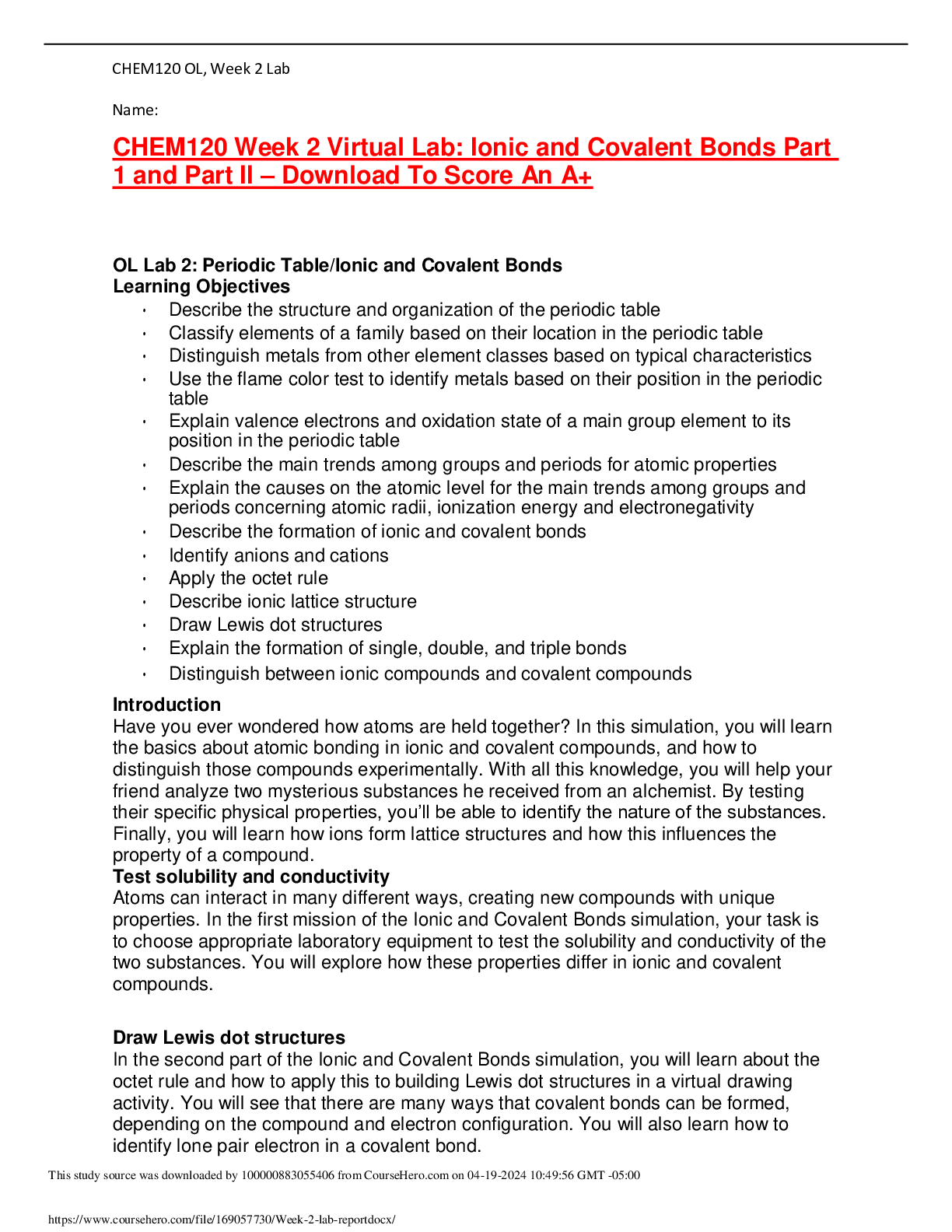*NURSING > Virtual Clinical Experiment (VCE) > NUR 321 VCE #4 Lesson 10- Medication Administration | • Piya Jordan and Kathryn Doyle_ Solved 2021 (All)
NUR 321 VCE #4 Lesson 10- Medication Administration | • Piya Jordan and Kathryn Doyle_ Solved 2021
Document Content and Description Below
Reading Assignment in Potter, P., Perry, A., Stockert, P., & Hall, A. (2016). Fundamentals of nursing (9th ed.). St. Louis, MO: Elsevier Mosby. • Medication Administration Patients: • Pi... ya Jordan, Medical-Surgical Floor, Room 403 • Kathryn Doyle, Skilled Nursing Floor, Room 503 Objectives: • Discuss the rationale for the medications ordered for two patients. • Explain the six rights of medication administration. • Perform medication dosage calculations. • Identify potential sources of medication errors. • Describe the steps required for medication administration. Exercise 1 Writing This exercise will take approximately 30 minutes to complete. 1. The name of a medication is an exact description of it's composition and molecular structure. 2. The trade name, brand name, or name is the official name under which a manufacturer markets a medication 3. After taking a prescribed medication, a patient reports feeling very tired. The nurse caring for the patient consults a drug handbook and determines that the medication is not associated with drowsiness. What term is used to refer to this type of patient reaction? A. Side effect B. Toxic effect C. Allergic reaction Ans: 4. The physician has ordered laboratory studies to evaluate the peak and trough of a medication. Which of the following statements concerning these terms is correct? Select all that apply. a. Peak refers to the time it takes for a medication to produce a response after it is administered. b. Peak refers to the time it takes for a medication to reach its highest effective concentration. c. Trough refers to the length of time of the therapeutic response produced by a medication. d. Trough refers to the smallest serum concentration of medication present before the next scheduled dosage. e. Trough refers to the amount of medication needed to produce a therapeutic response. 5. When two medications have a(n) their combined effect is greater than the effect of the medications given separately. Indicate whether the following statement in true or false. 6. Medications intended for sublingual administration may not have the desired effect if swallowed. 7. Which of the following statements describe activities for correctly following the six rights of medication administration? Select all that apply. a. Compare the MAR with the physician's written order for the name of a medication. b. Review the patient's record for allergies. c. Review the supply cart for available sizes of syringes. d. Check the MAR against the physician's written order for the route of administration. e. Compare the physician's written order for a medication with the times selected on the MAR for scheduled administration. 8. Which of the following sites is preferred for administering an intramuscular (IM) injection to an adult? a. Vastus lateralis b. Ventrogluteal c. Deltoid d. Dorsogluteal 9. What is the Z-track method? What is the benefit of using this method? It is recommended that, when administering IM injections, the Z-track method be used to minimize local skin irritation by sealing the medication in muscle tissue. To use the Z- track method, put a new needle on the syringe after preparing the medication so no solution remains on the outside needle shaft. Then select an IM site, preferably in a large, deep 651muscle such as the ventrogluteal muscle. Place the ulnar side of the nondominant hand just below the site and pull the overlying skin and subcutaneous tissues approximately 2 to 3 cm (1 to 1.2 inches) laterally or downward (Hopkins and Arias, 2013; Nicoll and Hesby, 2002). Hold the skin in this position until you administer the injection. After preparing the site with an antiseptic swab, inject the needle deep into the muscle. Grasp the barrel of the syringe with the thumb and index finger of the nondominant hand and slowly inject the medication if there is no blood return on aspiration. (pg.650-51) 10. Identify the characteristics of the Z-track method. Select all that apply. a. Technique for administering intramuscular (IM) injections b. Minimizes local skin irritation c. Allows medication to escape from the muscle tissue d. Seals medication in muscle tissue e. Needle remains inserted for 30 seconds to allow for even dispersal of medication 11. List the six rights of medication administration. (Potter, pg. 626) 12. Identify the four steps involved in the process for medication reconciliation. (Potter, pg.626) 1. ____Obtain a comprehensive and current list of a patient's medications whenever he or she experiences a change in health care setting (e.g., during admission, transfer, discharge). Include all current prescriptions and over-the-counter (OTC) medications. 2. ______: Review what the patient was taking at home or preadmission and make sure that the list of medications, dosages, and frequencies is accurate. Compare this list to the current ordered medications and treatment plan to ensure accuracy. Include family caregiver in this discussion when appropriate. 3. ___: Compare new medication orders with the current list; investigate any discrepancies with the patient's health care provider and document changes. 4. _______: Ensure that all the patient's health care providers have the most updated list of medications. Communicate and verify changes in medications as with the patient. Exercise 2 Online This exercise will take approximately 30 minutes to complete. Sign in to work at Pacific View Regional Hospital on the Medical-Surgical Floor for Period of Care 2. (Note: If you are already in the virtual hospital from a previous exercise, click on Leave the Floor and then on Restart the Program to get to the sign-in window.) • From the Patient List, select Piya Jordan (Room 403) • Click on Get Report and then on Go to Nurses' Station. • Click on Chart and then on 403. • Click on and review the History and Physical, Nurse's Notes, and Physician's Orders. 13. The physician has ordered enoxaparin 40 mg subQ. The administration of this medication will require a(n) -gauge needle. 14. Which of the following sites is the best location for administering enoxaparin to Piya Jordan? a. Deltoid b. Abdomen c. Thigh d. Buttocks Ans: 15. The angle range for administering a subcutaneous injection is 45 to 90 degrees. What factors will be used to determine the correct angle placement for administering the subcutaneous injection to Piya Jordan? To ensure that a subcutaneous medication reaches the subcutaneous tissue, follow this rule: If you can grasp 2 inches (5 cm) of tissue, insert the needle at a 90-degree angle; if you can grasp 2.5 cm (1 inch) of tissue, insert the needle at a 45-degree angle. 16. During the video interaction, the nurse communicates plans to administer Tylenol to Piya Jordan. Has this medication been ordered by the physician? Are any additional actions needed before this medication can be administered? Exercise 3 Online This exercise will take approximately 15 minutes to complete. • Sign in to work at Pacific View Regional Hospital on the Skilled Nursing Floor for Period of Care 2. (Note: If you are already in the virtual hospital from a previous exercise, click on Leave the Floor and then on Restart the Program to get to the sign-in window.) • From the Patient List, select Kathryn Doyle (Room 503). • Click on Get Report; review the report and then click on Go to Nurses' Station. • Click on Chart and then on 503. • Click on and then review the History and Physical, Nurse's Notes, and Physician's Orders. 17. What patient data should be checked before beginning to remove medications from the dispensing system? Select all that apply. a. Fluid intake for last 8 hours b. Vital signs at 0700 c. Medication Administration Record d. Activity order e. Allergy record Ans: 18. Kathryn Doyle has documented issues with dehydration. If she asks you to crush her medications and mix them with applesauce, what actions are indicated prior to crushing them? 19. Discuss actions that must be taken to crush the medications. Discuss the associated rationale. (Potter 627) 20. When planning Kathryn Doyle's care, you must remember that critical medications are to be administered within minutes of their ordered time. [Show More]
Last updated: 1 year ago
Preview 1 out of 6 pages
.png)
Reviews( 0 )
Document information
Connected school, study & course
About the document
Uploaded On
Jun 23, 2021
Number of pages
6
Written in
Additional information
This document has been written for:
Uploaded
Jun 23, 2021
Downloads
0
Views
135

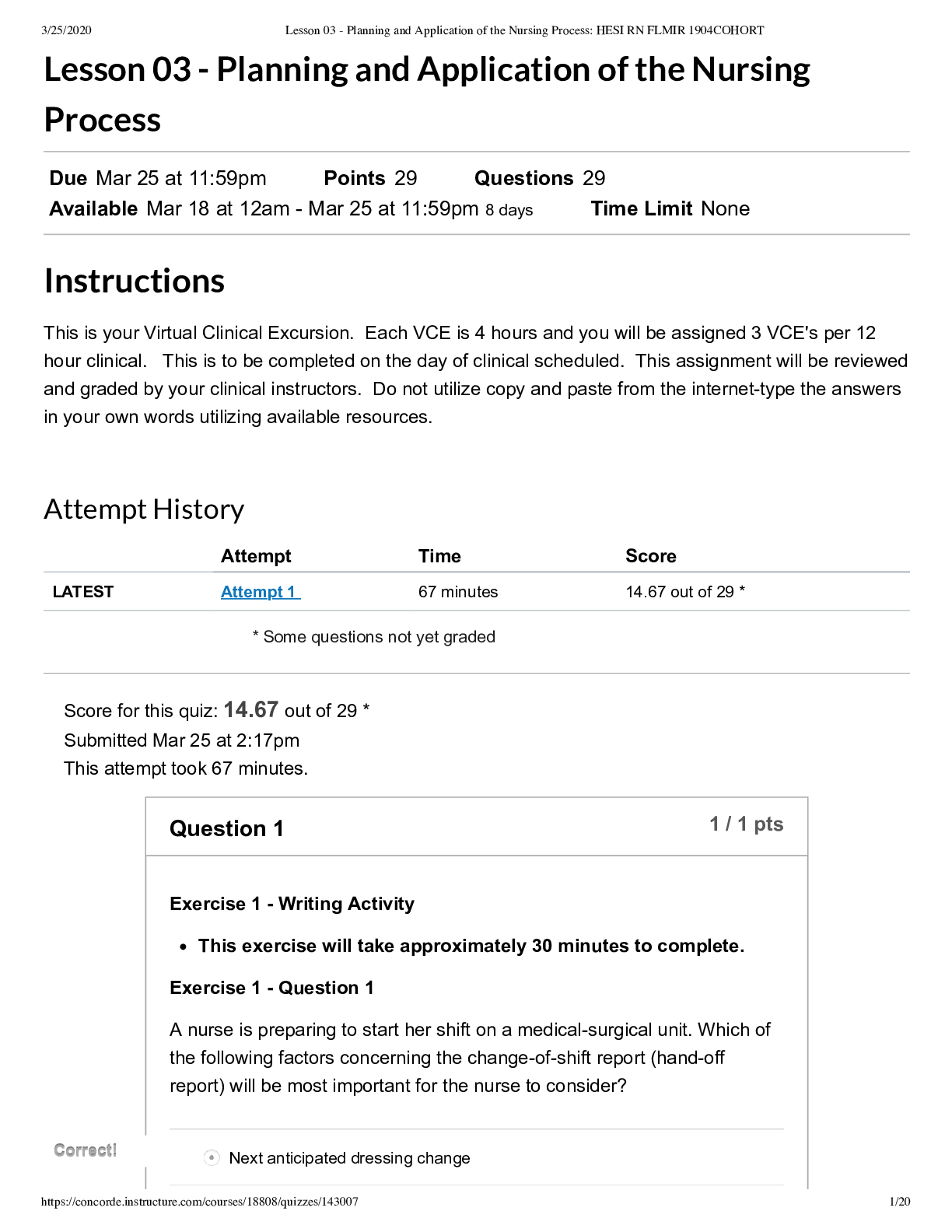
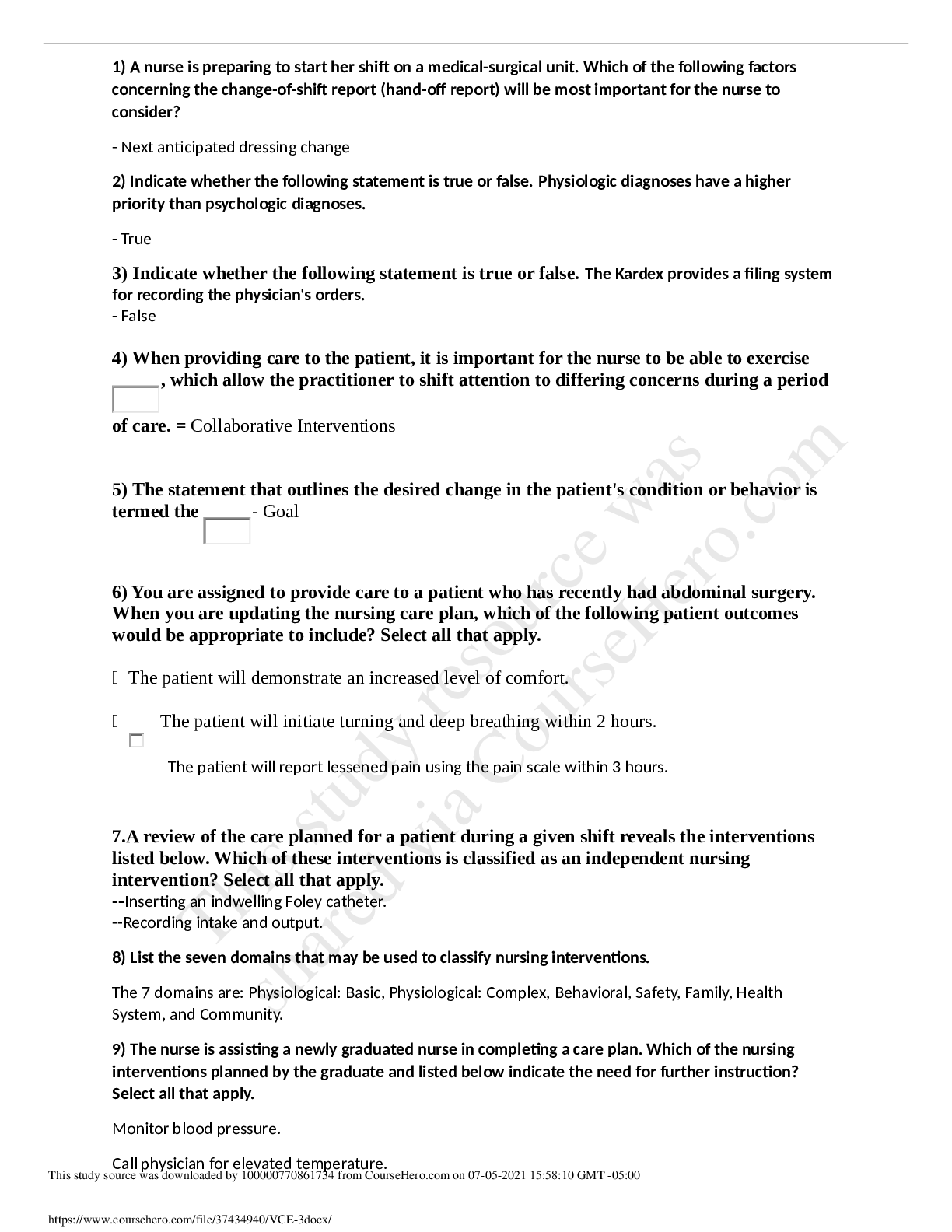
.png)
.png)

